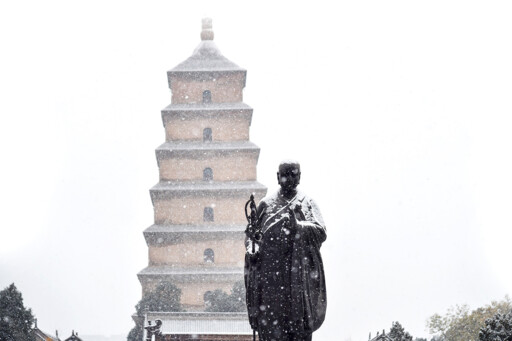


Capital of verse: Chang’an in Tang literary imagination

Statue of the Buddhist monk Xuanzang in front of Giant Wild Goose Pagoda, a monumental Buddhist pagoda built during the Tang Dynasty, situated in Xi’an, where the capital of the Tang Dynasty was located Photo: IC PHOTO
In Tang (618—907) history, beyond from the real Chang’an, there existed a “Chang’an” shaped by literature. Building on the image of the actual capital, writers employed imagination and fiction to craft an idealized city.
Multiplicity of Chang’an: Spectacle and the everyday
In the early Tang, capital-themed poetry—exemplified by the works of the Four Talents [Lu Zhaolin, Luo Binwang, Liu Xiyi, and Zhang Ruoxu]—focused on grand depictions of the city’s roads and vistas, often using the metaphor of a “road to the heavens” as a path toward ideals. After the Tianbao era (742—756), however, works increasingly depicted everyday life in the capital. Rather than praising prosperity and peace, these poems portrayed urban alleys, marketplaces, and popular customs.
Tang tales (chuanqi) also contained vivid portrayals of street life. From the mid-Tang onward, the alleys became important spaces for literati activity, with protagonists frequently drawn from those living in narrow backstreets—for example, Huo Xiaoyu in The Tale of Huo Xiaoyu, who resided in Shengye Fang [In the context of Tang Dynasty Chang’an, fang refers to a walled urban ward or neighborhood], and Li Wa in The Tale of Li Wa, who dwelled in Pingkang Fang. Following these winding alleys led one to another world beneath the solemn surface of Chang’an: the external and internal, the real and the imagined, intertwined to form multifaceted visions of the city in the memory of later generations.
Chang’an by night
Tang capital literature also paid close attention to the city at night, creating an “After-Dark Chang’an” distinct from its daytime appearance. The city’s prosperity fostered a desire for nightlife, yet the strict ward system and night curfew restricted nocturnal amusement. Whenever prohibitions were lifted, enthusiasm for night roaming surged. During the three nights around the Lantern Festival, when the curfew was suspended, the entire populace poured into the streets. Spectacular nocturnal scenes, filled with carnival spirit, became a major theme in literary accounts. Tang texts such as Da Tang Xin Yu (New Anecdotes of the Great Tang) and Kaiyuan Tianbao Yishi (Tales of the Kaiyuan and Tianbao Eras) vividly described Chang’an at night—ablaze with lanterns, the whole city reveling in celebration.
Beyond seasonal festivals, hidden spaces within Chang’an also catered to nocturnal life. In lively wards such as Pingkang Fang, even after the ward gates closed, the inner streets remained bustling. Tang notes such as Sun Qi’s Beili zhi (Record of the North Ward) depict this striking contrast between the darkness outside the walls and the brightness within. Alongside courtesans, the classic figure of the “knight-errant thief” in Tang tales also embodied After-Dark Chang’an, slipping into princely mansions with ease. Under the cover of night, these figures roamed freely throughout the city, eroding the rigid spatial divisions of Chang’an. Such works complemented the city’s image, presenting it as wild, flamboyant, and unrestrained—an urban space full of vitality.
Personal memory of the capital
After the An Lushan Rebellion, the Tang Dynasty declined. Scholars, lamenting reality or seeking solace, began to reconstruct the “capital of the Kaiyuan era.” Using legendary narrative techniques infused with imagination, they built a city of memory, both real and illusory. Typical characters included Pear Garden actors [professional performers trained in music, dance, and drama during the Tang era], palace women fallen into exile, and white-haired elders, whose fates of dispersal and decline embodied the sorrow of a fallen dynasty.
Among these, the image of the Pear Garden disciples was especially telling. The Pear Garden, a royal performance academy founded by Emperor Xuanzong, once trained thousands. After the rebellion, “half of the Pear Garden disciples had fled or perished, and their songs were silenced.” Their fate mirrored the dynasty’s decline. In this way, individual destinies became entwined with the glory—and the fall—of Chang’an, evoking deep empathy among writers.
In addition to characters, various objects also carried legendary weight. Artifacts once close to the palace favor became treasured remnants of Chang’an’s golden age, stirring nostalgic remembrance. For example, Zheng Yu’s commentary on the poem “Jinyangmen Shi” notes a horse that once danced to music but was later conscripted into the army and beaten to death as a demon—emblematic of the capital’s lost grandeur.
Long Tang poems often revealed autobiographical tendencies. Writers such as Luo Binwang and Li Bai, when recounting their lives, devoted lengthy passages to palaces, avenues, and gardens, linking these capital spaces to their personal memories and experiences. In such works, the city transcended geography, becoming a sacred place of the mind, a spiritual home, and a symbol of youth and ideals. When literati later left the capital and wandered to borderlands, they often recalled Chang’an’s splendor upon encountering similar landscapes. Works such as Du Fu’s “Watching Gongsun’s Disciples Perform the Sword Dance” and Xue Feng’s “Drunken in Spring Breeze” sought to fill the desolation they faced with memories of Chang’an’s glory. Yet such solace was fleeting and illusory, as reality inevitably revealed the stark contrast between prosperity and decline.
Reflecting on how Tang capital literature shaped Chang’an is not merely revisiting history. It also invites reconsideration of the symbiotic relationship between literature and the city, offering cultural nourishment and aesthetic guidance for urban development today.
Xin Xiaojuan is a professor from the School of Chinese Classics at Renmin University of China.
Copyright©2023 CSSN All Rights Reserved